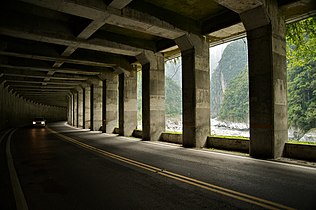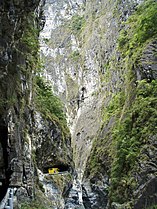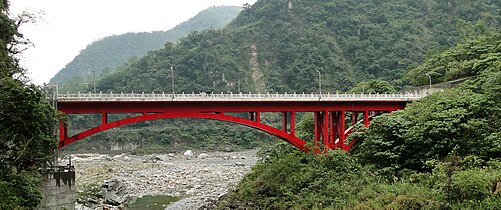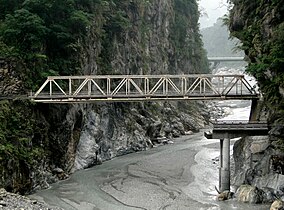Taroko National Park
| Taroko National Park 太魯閣 國家 公園 |
||
|---|---|---|
| Pedestrian suspension bridge in the Taroko Gorge | ||
|
|
||
| Location: | Taiwan | |
| Next city: | Hualien | |
| Surface: | 920 km² | |
| Founding: | November 28, 1986 | |
| Visitors: | 4,504,850 (2016) | |
| Address: | www.taroko.gov.tw | |
The Taroko National Park ( Chinese 太魯閣 國家 公園 , Pinyin Tàilǔgé gúojiā gōngyuán , Pe̍h-ōe-jī Taroko kok-ka kong-hn̂g ) is one of eight national parks in the Republic of China (Taiwan) , located in the east of the island of Taiwan . It was named after the Taroko Gorge, which in turn was named after the Truku indigenous people. With 4.5 million visitors, the park was the second most visited in Taiwan in 2016.
location
The park is located in the east of Taiwan in the area of the two counties of Hualien and Nantou as well as in the urban area of Taichung . The area is 92,000 hectares , of which 74,800 hectares are in the area of Xiulin Township ( 鄉 鄉 ) in Hualien, 9500 hectares in the area of Heping (in 區 ) in Taichung and 7700 hectares in Ren'ai ( 仁愛 鄉 ) in Nantou .
history
Taroko National Park is the oldest national park in Taiwan. It was first established on December 12, 1937 during the Japanese colonial period as Tsugitaka Taroko National Park ( 次 高 タ ロ コ 国立 公園 Tsugitaka Taroko kokuritsu kōen ). At the time, the park also included the Xueshan with a total area of 270,000 hectares. However , the design plans came to a standstill during the Second World War . After it was taken over by the Republic of China, the park was closed on August 15, 1945 and only rebuilt on November 28, 1986. The establishment of such a large area as a national park was of great importance for the nature conservation movement in Taiwan and an expression of the increased environmental awareness after decades of relatively unchecked economic growth.
Attractions
The park is mainly famous for its gorges and steep cliffs. The park includes the following attractions:
-
Taroko Gorge ( 太魯閣 峽谷 , Tàilǔgé xiágǔ )
The Liwu River ( 立 霧 溪 ) flows through it , which eroded the marble layer and formed the gorge. It is a famous landmark in Taiwan because of the view. - Tunnel of Nine Twists ( 九曲洞 , Jiǔqūdòng )
-
Shrine of Eternal Spring ( 長春 祠 , Chángchūn Cí )
This shrine was built in memory of the 212 construction workers who died during the construction of the east-west highway. -
Swallow Grotto ( 燕子 口 , Yànzikǒu )
The name comes from the many small caves in the rock face in which swallows have built their nests. -
The Bridge of the Loving Mother ( 慈母 橋 , Címǔqiáo )
A bridge made of red marble. -
Tianxiang ( 天祥 )
There are many accommodations and restaurants here.
traffic
Provincial Road 8 ( 中 橫 公路 , Zhōnghéng Gōnglù ), which connects the west with the east of Taiwan, runs through the park . The Taroko Gorge can be reached in the following ways:
- There is a bus from Hualian train station to the entrance of the Taroko Gorge (journey time approx. 60 minutes) and to the final stop Tianxiang (90 minutes).
- From Hualien Airport by car about 30 minutes.
- The park is 3 km away from Xincheng Train Station.
- Because the gorge stretches over a large area, hotels in Hualien offer guided tours.
photos
See also
Web links
Individual evidence
- ↑ 統計 資料 (“Statistical Data”). National Parks of Taiwan, Retrieved July 14, 2018 (Chinese).
- ↑ 各 國家 公園 基本 資料 表 (“Basic information table about the national parks”). October 5, 2009, Retrieved July 6, 2019 (Chinese (traditional), English).
- ^ About the Park> General Information> Introduction. Taroko National Park website, accessed January 6, 2018 .














